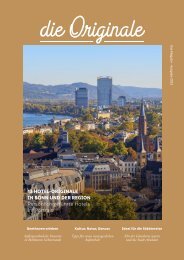LUXAIR_LUXiClub_So12 ls
p o
p
o
Create successful ePaper yourself
Turn your PDF publications into a flip-book with our unique Google optimized e-Paper software.
Number 43, Fall 2002
cartographic perspectives 43
Getting Real: Reflecting on the New
Look of National Park Service Maps
o make more inviting and understandable maps for general audiences,
the U.S. National Park Service has been experimenting with
cartographically realistic map design. Using rasterized geodata and
unconventional image processing techniques, cartographic realism draws
inspiration from traditional cartographic art, modern graphic design, observations
of nature, and aerial photograph maps. The aim is to combine
the best characteristics of imagery and maps into a more intuitive hybrid
product. Discussed techniques include aquafication, texture substitution,
illuminated relief, and outside land muting.
Tom Patterson
U.S. National Park Service
Harpers Ferry Center
Harpers Ferry, WV 25425
t_patterson@nps.gov
Keywords: Cartographic realism, park landscapes, shaded relief, illuminated
relief, cartographic art, Walensee, aerial photograph maps, Aitutaki,
raster map design.
Note on illustrations: The online version of this paper (www.nacis.org/
cp.html) contains color illustrations. Map samples of the described techniques
are located in the color section at the back of this issue.
This paper examines the techniques being developed by the U.S. National
Park Service (NPS) Harpers Ferry Center for designing plan (2D) maps
with a faux realistic look. The NPS produces tourist maps for 388 parks in
a system spanning a large swath of the Earth’s surface from the Caribbean
to Alaska to the South Pacific, and which is visited by nearly 300 million
people each year. Many park visitors are inexperienced map readers and
non-English speakers. In our ongoing effort to make NPS maps accessible
to everyone, the design of NPS maps has become less abstract and increasingly
realistic, particularly in the depiction of mountainous terrain and
natural landscapes (Figure 1). Many of the techniques discussed herein are
borrowed from or inspired by 3D mapping (Patterson, 1999). However,
the scope of my paper deals exclusively with plan mapping—a format
that has received scant attention in the digital era in regard to abstract vs.
realistic depiction compared to the 3D world. It is also the format in which
the majority of NPS maps will continue to be made.
Cartographic Realism
As one would expect, the term “realism” occurs frequently throughout
this paper. It is important to define the meaning of this term in the cartographic
context before continuing. Webster’s New World Dictionary defines
realism, in the artistic sense, as:
The picturing in art and literature of people and things as it is thought
they really are, without idealizing.
Applying this definition to maps is problematic because all maps (and
even many remotely sensed images) are idealized representations of the
Earth and are inherently abstract. On the other hand, most of us would
agree that some maps appear more realistic and are more intuitively
comprehensible than others. For example, a shaded relief map with terrain
represented by softly modulated light and shadows appears more realistic
than a contour map with a multitude of isolines connecting points of equal
INTRODUCTION
“In our ongoing effort to make
NPS maps accessible to
everyone, the design of NPS
maps has become less abstract
and increasingly realistic,
particularly in the depiction of
mountainous terrain and
natural landscapes.”















